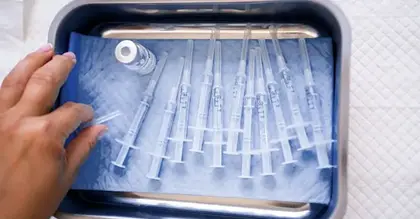Generic Name: HUMAN CYTOMEGALOVIRUS IMMUNE GLOBULIN 2500mg in 50mL
Dosage Form: injection
Drug Class: Immune globulins
The maximum recommended total dosage per infusion is 150 mg Ig/kg, administered according to the following schedule:
| Type of Transplant | ||||
| Kidney | Liver, Pancreas, | |||
| Lung, Heart | ||||
| Within 72 hours of transplant: | 150 mg/kg | 150 mg/kg | ||
| 2 weeks post transplant: | 100 mg/kg | 150 mg/kg | ||
| 4 weeks post transplant: | 100 mg/kg | 150 mg/kg | ||
| 6 weeks post transplant: | 100 mg/kg | 150 mg/kg | ||
| 8 weeks post transplant: | 100 mg/kg | 150 mg/kg | ||
| 12 weeks post transplant: | 50 mg/kg | 100 mg/kg | ||
| 16 weeks post transplant: | 50 mg/kg | 100 mg/kg | ||
Preparation for Administration. Remove the tab portion of the vial cap and clean the rubber stopper with 70% alcohol or equivalent. DO NOT SHAKE VIAL; AVOID FOAMING.
Parenteral drug products should be inspected visually for particulate matter and discoloration prior to administration whenever solution and container permit. Infuse the solution only if it is colorless, free of particulate matter and not turbid.
Infusion. Infusion should begin within 6 hours after entering the vial and should be complete within 12 hours of entering the vial. Vital signs should be taken preinfusion, mid-way and post- infusion as well as before any rate increase. CytoGam® should be administered through an intravenous line using an administration set that contains an in-line filter (pore size 15μ) and a constant infusion pump (i.e., IVAC pump or equivalent). A smaller in-line filter (0.2μ) is also acceptable. Pre-dilution of CytoGam® before infusion is not recommended. CytoGam® should be administered through a separate intravenous line. If this is not possible, CytoGam® may be “piggybacked” into a pre-existing line if that line contains either Sodium Chloride Injection, USP, or one of the following dextrose solutions (with or without NaCl added): 2.5% dextrose in water, 5% dextrose in water, 10% dextrose in water, 20% dextrose in water. If a pre-existing line must be used, the CytoGam® should not be diluted more than 1:2 with any of the above- named solutions. Admixtures of CytoGam® with any other solutions have not been evaluated.
Initial Dose. Administer intravenously at 15 mg Ig per kg body weight per hour. If no adverse reactions occur after 30 minutes, the rate may be increased to 30 mg Ig/kg/hr; if no adverse reactions occur after a subsequent 30 minutes, then the infusion may be increased to 60 mg Ig/kg/hr (volume not to exceed 75 mL/hour). DO NOT EXCEED THIS RATE OF ADMINISTRATION. The patient should be monitored closely during and after each rate change.
Subsequent Doses. Administer at 15 mg Ig/kg/hr for 15 minutes. If no adverse reactions occur, increase to 30 mg Ig/kg/hr for 15 minutes and then increase to a maximum rate of 60 mg Ig/kg/hr (volume not to exceed 75 mL/hour). DO NOT EXCEED THIS RATE OF ADMINISTRATION.
The patient should be monitored closely during each rate change.
CytoGam® should be used with caution in patients with pre-existing renal insufficiency and in patients judged to be at increased risk of developing renal insufficiency (including, but not limited to those with diabetes mellitus, age greater than 65, volume depletion, paraproteinemia, sepsis and patients receiving known nephrotoxic drugs). In these cases especially, it is important to assure that patients are not volume depleted prior to CytoGam® infusion. While most cases of renal insufficiency have occurred in patients receiving total doses of 350 mg Ig/kg or greater, no prospective data are presently available to identify a maximum safe dose, concentration or rate of infusion in patients determined to be at increased risk of acute renal failure. In the absence of prospective data, recommended doses should not be exceeded and the concentration and infusion rate selected should be the minimum practicable.
Potential adverse reactions are: flushing, chills, muscle cramps, back pain, fever, nausea, vomiting, wheezing, drop in blood pressure. Minor adverse reactions have been infusion rate related – if the patient develops a minor side effect (i.e., nausea, back pain, flushing), slow the rate or temporarily interrupt the infusion. If anaphylaxis or drop in blood pressure occurs, discontinue infusion and use antidote such as diphenhydramine and adrenalin.
To prevent the transmission of hepatitis viruses or other infectious agents from one person to another, sterile disposable syringes and needles should be used. The syringes and needles should not be reused.




